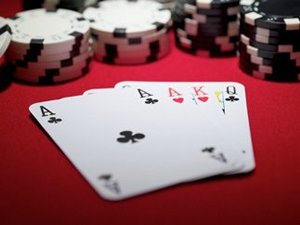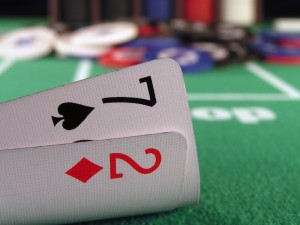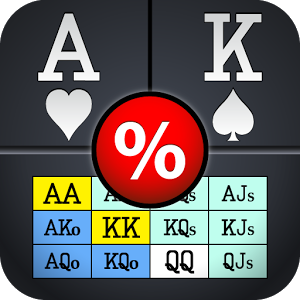Naked, weak-stab, and semibluff
In my last column, I discussed the basics of floating in pot-limit Omaha (PLO) and identified the key indicators – the weak stab, the continuation-bet, and a possible steal bet – that a float may be in order. In this column, we’ll take a look at the more basic variations of the float, and work our way toward some more complex variations in future columns.
Naked Float
The game: $1-$2 PLO online (six-max, deep)
Your hand: K J
J
















Preflop: Everybody folds around to the small blind ($196.50), who raises to $6. You ($535.70) call. (Pot: $12)
Flop: 9





















Turn: A







The Float
Heading to the flop, this is a pretty favorable situation, as you are heads up with the positional advantage. The 9-2-2 flop is not a typical floating flop, as it is more difficult to represent a deuce on this flop than it is to represent an 8 if the flop were instead 9-8-8. And if by some chance your opponent has what he says he has (A-A, 9-9, or a deuce), you also have no real hand or draw whatsoever, and as such are running naked in the hand. As a result, the float depends almost entirely on the probability that your opponent doesn’t have something like A-A, 9-9, or a deuce himself.
The key is that a lot of players would play any four cards the same way from his position, so he doesn’t necessarily have A-A here. I mean, if you were the small blind, what would you do with something like 9-8-7-6 or K-Q-J-10? You’d probably play it about the same way. In fact, I think most players would prefer to make a smaller bet on the flop with A-A, as it is difficult to catch up to on this kind of flop with an open pair.
The A♠ on the turn is a pretty good scare card if it didn’t hit your opponent. And even if it did, your call on the flop appears strong to him. Either way, his check is an invitation to bet. If by some chance you get called, you can shut down then.
Indicators: Continuation-bet/first bet in heads-up pot on the flop, check on the turn
Weak-Stab Float
The game: $5-$10 PLO
Your hand: Q





























Preflop: An early-position player ($700) limps in. The next player ($5,000), a loose and frequent raiser preflop, raises to $50.
Everyone folds to the player in front of you ($1,500), who calls. You ($3,500) call. The early-position limper calls. (Pot: $215)
Flop: J



















Turn: K






The Float
In this hand, you have an overpair and a gutshot on the flop on a board with a possible straight out. The first two players likely would have bet out if they had the straight. The next player makes a weak $150 bet into a $215 pot, when you’d expect him to bet the full pot if he actually had the straight.
My feeling is that he has something like two pair or maybe a set at best. By calling, you can represent the straight or a set, and see what he does on the turn. Calling is fairly consistent with the way I would play the bare nut straight (no redraw) or a set. It also doesn’t hurt that I know this player well, having played with him regularly, and I know that he is apt to shut down unimproved and give me credit for the straight.
You do run the slight risk of having one of the other two players come into the pot if he has a set. But in the actual hand, I felt strongly enough about the bettor that I thought it was worth the risk.
The turn card gave me an open-end straight draw, and I just as easily could have checked behind and taken the free card. But from my perspective, my fold equity gained by calling on the flop is high enough that it would be a mistake not to bet the pot and take it down here, rather than wait until the river and give up the chance to faithfully represent the straight.
Indicators: Weak stab on the flop, check on the turn
Semibluff Float
The game: $1-$2 PLO with $5 bring-in ($500 max)
Your hand: Q


























Preflop: Two players limp in for $5, and the hijack position ($600) raises to $30. The cutoff folds. You ($1,300) call. Both blinds fold, and only one of the limpers ($700) calls.
Flop: K














Turn: 3






The Float
In a full-ring game, a player who almost never raises before the flop but all of a sudden comes out with a pot-sized raise preflop – signaling A-A – is a pretty strong candidate for a float if you can see the flop shorthanded with positional advantage. These players tend to be conservative by nature, and try not to get too involved with unimproved A-A after the flop. As such, they are often exactly the kind of players you are looking for – the one-shot-and-done type.
So, if there is a good chance that I am going to be shorthanded (preferably heads up) after the flop, I will call raises from this kind of player with a wider-than-normal range of hands.
The preflop raiser in this hand is someone I had played with several times, and someone who rarely had ventured a preflop raise up until this point. His pot-sized raise here most likely signals A-A. Meanwhile, one of the interesting things about the structure of the game we were playing is that the small size of the blinds relative to the action sometimes promotes shorthanded pots. I called here, anticipating a shorthanded pot with positional advantage.
The flop gave me a weak 13-card wrap with only seven nut outs – and five if I give the preflop raiser credit for A-A. I also am dominated by a hand like A-K-Q-10 and in poor shape against something like K-Q-J-10 or K-K-Q-10. As such, this hand is not really worth a call on its own merits, and raising could be a disaster when I am wrong. Plus, there is a third player in the hand who could be trapping.
All in all, this is a fairly marginal situation. But in this case, I went ahead and called the pot-sized continuation-bet to see if the preflop raiser was serious about the hand. He wasn’t; the other player folded, the preflop raiser checked on the turn, I bet the pot, and he folded.
Indicators: Continuation-bet on the flop, check on the turn
That’s it for this column. In my next column, we’ll take a look at the combo float.
This article was originally written by Jeff Hwang. Jeff Hwang is a semiprofessional player and author of Pot-Limit Omaha Poker: The Big Play Strategy. His latest book is Advanced Pot Limit Omaha Vol.1 and will be releasing Vol 2.
Submit your review | |










